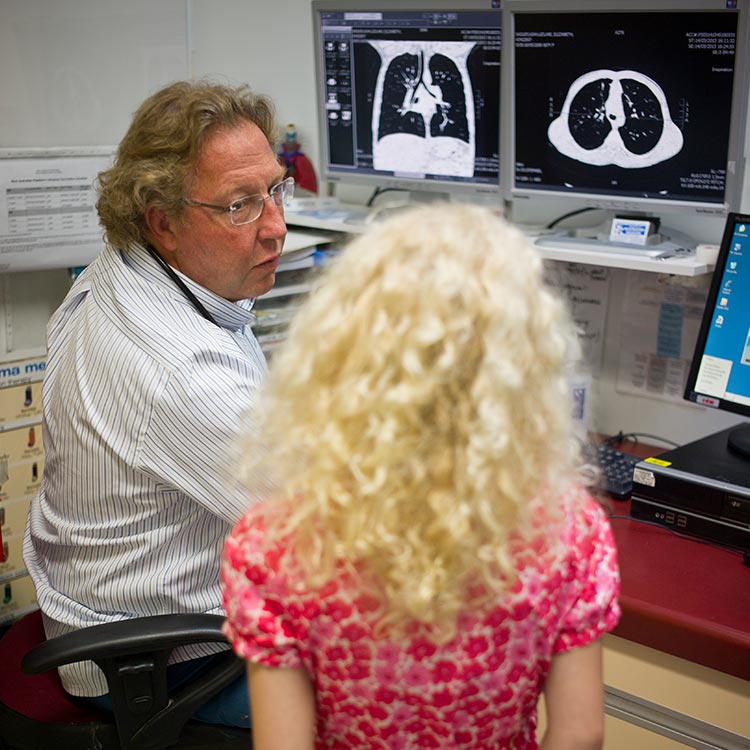 Research transforms approach to cystic fibrosis
Research transforms approach to cystic fibrosis
Early intervention is being touted as the key to preventing lung damage in children with cystic fibrosis.
The Australian Respiratory Early Surveillance Team for Cystic Fibrosis (AREST CF) was formed in 2004, under the overarching premise that minimising lung damage in early childhood was the best strategy for reducing its impact later in life.
In his role as principal investigator, Professor Stephen Stick from The Kids Research Institute Australia has focussed attention on early manifestations of CF lung disease in children aged under seven.
“We have identified inflammation in the lungs as a key factor in the progression of early lung disease and have developed new ways to monitor disease progression,” he said. “These findings have been incorporated into the first clinical trial to prevent lung disease in children diagnosed with CF following newborn screening.
“Despite appearing healthy and having few symptoms, the majority of six-year-old children with cystic fibrosis already have progressive lung disease and subtle changes in lung structure are evident in children from three months of age.”
Cystic fibrosis is one of the most common fatal hereditary diseases, with more than half of patients dying before the age of 50.
Caring for a child with CF takes a toll on families, with up to four hours a day needed for various treatments, including multiple medications and a special diet.
“Surprisingly little is known about the role of antibiotics and their effectiveness for prevention of lung disease in early life,” Professor Stick said.
“Our studies in the first years of life are identifying which bugs are most likely to be causing problems and this will help us design trials of antibiotics in this age-group. In older children, antibiotics combined with regular physiotherapy are the cornerstones of therapy that reduce the impact of chronic inflammation, mucous obstruction of airways and infection.”
Professor Stick said bronchiectasis, which is destruction of the airways in the lung due to chronic inflammation and infection, was once thought to be a process that usually affected children beyond adolescence.
But the AREST CF researchers have demonstrated problems much earlier.
“We have observed using CT scans of the lungs that bronchiectasis can occur in children as young as three months and by five years of age the majority of children have evidence of bronchiectasis, albeit only affecting small areas of lung,” Professor Stick said.
The team has also discovered that children with neutrophil elastase, a potentially damaging by-product of inflammation, in their lungs at three months are at higher risk of developing bronchiectasis by the age of three.
“We have developed special techniques that can detect disease that affects as little as 2-3 per cent of the lung using ultra-low doses of radiation and sensitive image assessment tools,” he said.
“This realisation has caused a paradigm shift in our approach to management with a focus on prevention, early detection of lung damage and development of strategies to prevent lung damage.”
With improved detection and treatment, researchers believe CF lung disease can be prevented rather than ameliorated.
What is cystic fibrosis?
- Cystic fibrosis affects the lungs and digestive system because of a malfunction in the exocrine system, responsible for producing saliva, sweat, tears and mucus. There is no cure.
- People with cystic fibrosis develop an abnormal amount of thick and sticky mucus within the lungs, airways and digestive system. This mucus traps bacteria in the lungs resulting in recurrent infections. Lung failure is the major cause of death.
- Cystic fibrosis affects one in every 2500 babies born in Australia.
- The CF gene must be inherited from both parents - and it is carried by one in 25 people.
What’s next
Professor Stick, who also heads Respiratory Medicine at PMH, said in the next five years, it was hoped to:
- Identify new treatments that reduce inflammation that can be used to prevent lung disease.
- Develop simple tests that help monitor lung disease in the clinic and for clinical trials.
- Expedite clinical trials in young children, a group that have been neglected by the pharmaceutical industry.
- Investigate the plausibility of new gene repair technique to treat the basic genetic defect.
